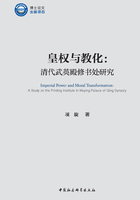
Abstract
The Printing Institute in Wuying Palace was set up in 1680 and ended in 1912 along with the disappearance of Qing Dynasty. It worked for 233 years and lasted for nine periods of Qing Dynasty. The Printing Institute in Wuying Palace was originally attached to the Wuying Palace Workshops,then gradually independent,directly under the control of Internal Affairs Department. It was made up of the Supervision Department,the Hanlin Proofreading Department and the Royal Calligraphy Department. In a word,it was a specialized organization which was in charge of imperial books' printing,proofreading and decoration.
This book takes the “Printing Institute in Wuying Palace” as the object of study to figure out its operation of proofreading,printing and decoration during more than two hundred years. This book also focuses on studying the establishment of the Printing Institute,official system,daily management,division of labor,book printing,the circulation process and other basic issues,to explore the daily operation of institute of imperial printing. Based on the investigation about the existing versions,the book tries to reveal the basic characteristics of versions printed in Wuying Palace. On the basis of the above research,this book seeks to further reveal the political and cultural connotations of Imperial editions of Wuying Palace.
This book includes seven chapters. Each chapter is made up of some sections. The first chapter introduces the printing tradition of central governments in ancient China and specially puts forward the relationship between the imperial printing by Jingchang of Ming Dynasty and the imperial printing by Wuying Palace of Qing Dynasty. This chapter also describes the institute's background of establishment from the perspective of political and cultural environment in the early Qing Dynasty. The second chapter examines the date and location of establishment of this institute and its relationship with the Wuying Palace Workshops. On the basis of several divided stages(Founding Period,Peak Period,Micro-period and Decline Period),this chapter emphasis on the system development and publication by Wuying Palace in various periods. Chapter Three discusses the organization structure,official system and personal management of the Printing Institute in Wuying Palace. This chapter examines the sources,quantities and treatment of various craftsmanship services that have been neglected in previous academic circles. Chapter Four focuses on the daily operation mechanism,including the funds,the material expenses,the coordination relationship with the Internal Affairs Government,Book-editing agency,Hanlin Academy,Guozijian,etc. It has established a complete organizational management system and logistical support system. Chapter Five explores the publication and collation of editions of Wuying Palace and points out the related problems of Juzhen Institute and Series of Precious Books in Wuying Palace. This chapter explores the reasons for the disappearance of more than 250,000 wooden movable characters in Juzhen edition. The sixth chapter describes the basic characteristics of engraving and paper and corrects some mistakes in the existing catalog publications about these editions by using a large number of documents. Chapter Seven investigates thoroughly the circulation process including the delivery,award,exhibition and sale. The chapter particularly focuses on the confiscating and sale,which are important parts of the circulation process. Finally,the book summarizes the whole work and puts forward some new thinking to discuss the nature,achievements,and limitations of the Printing Institute in Wuying Palace.
This book systematically and comprehensively clarifies the historical origin,development process and system operation of the most important “Royal Publishing House” in the Qing Dynasty,which is of great significance to the Chinese publishing history,book collection history,cultural history and many other fields. We can also further highlight the important status and value of the Printing Institute in Wuying Palace in the history of academy and the culture of the Qing Dynasty.
Key Words:Qing Dynasty;The Printing Institute in Wuying Palace;Imperial Editions of Wuying Palace;Publication;Politics and Culture